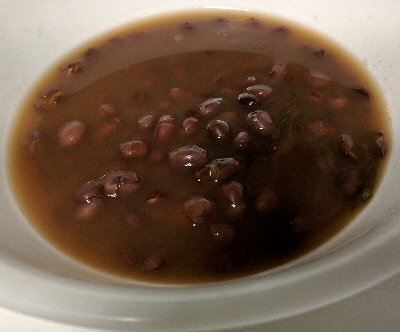
Adzuki beans (a.k.a. "azuki" beans) are a staple of the macrobiotic diet, which calls for the consumption of plenty of fibrous, protein-packed legumes. Macrobiotics considers adzukis to be the most "yang" of all beans, good for imparting strength, and they help people keep warm in cool weather. Known for their healing properties in Traditional Chinese Medicine, adzukis are said to support kidney, bladder and reproductive functions.
Cooking dried adzuki beans is tricky, lest they cook unevenly and remain tough on the inside. When correctly done, however, they are delicious, will keep for 2-3 days in the fridge, and enhance any meal. The key is steady, slow and gentle heat (and never boiling), applied for the correct minimum times. This recipe requires being near the stove on and off for several hours, but the results are well worth it when you can manage it.
Optionally, you can add chopped onion and/or winter squash in second half of cooking, and maybe reduce the liquid near the end to make more of a stew, but the beans are delicious all by themselves.
Lastly, if you don't have kelp ("kombu" in Japanese), and don't want to order any, this dish can be done without it (see notes below), but it will take even a little longer to cook.
Ingredients
Additional Notes
I learned the "bean shocking" technique below, specifically for cooking difficult-to-tender adzuki beans, in the book "Macrobiotic Home Remedies" by Michio Kushi and Marc Van Cauwenberghe MD, 2007.
Instructions
- Wash beans, then cover with 1" water and soak overnight at room temperature in a pot with the lid ajar.
- Soak a postage-stamp-sized piece of dried kelp (aka "kombu") in a little filtered water. Remove the kelp, discard its soak-water, wipe off any white residue from the kelp, then add the kelp to the beans in their cooking pot. Add filtered water as needed to cover beans with 1" of water.
- Slowly bring the pot to an almost-boil. It's ideal to use a flame tamer under the pot. Reduce burner to simmer, where it's not quite boiling. Ideally, never let this cooking pot break out into an actual boil. See Note 2 below.
- Use a timer to check liquid every 20-30 minutes, adding water if needful to keep beans covered.
- After 1.5 hours or so (but see Note 3 below), remove from burner. Drain liquids to a holding pan, place beans in a collander, and shock them with cold water until they've lost all heat. See Note 1 below.
- When the poured-off liquids have cooled, restore them to the pot along with the rinsed beans, add water to cover again with 1" liquid, and recook in the same way as above.
- After simmering 1.5 or so more hours, the beans will be cooked evenly inside and outside.
- Add salt to taste (not too much!--for 3/4 cup dried beans to start, try it with no more the 3/4 teaspoons sea salt to begin) and simmer beans another 10 minutes to chelate the salt to the beans.
- Turn off burner, and begin enjoying the beans immediately. They'll keep 2-3 days in the fridge, so compound recipe to make as much or as little as you want in a given batch of beans.
Note 1: The reason for the shocking the beans? To tender their insides correctly.
Note 2: By cooking kelp but not quite boiling it, you get all the good qualities of kelp and none of the bad. If you let the dish boil, the kelp will emit a strong taste and the end result won't be quite as nice. Gentle, steady cooking is the goal.
Note 3: If you don't have the kelp, you can still make this dish, but cook at least 2 hours each time. The kelp speeds the cooking and also adds minerals and a fine taste to the beans. But don't use too big a piece (and as stated above, try not to boil kelp). (Recipe♦104)
